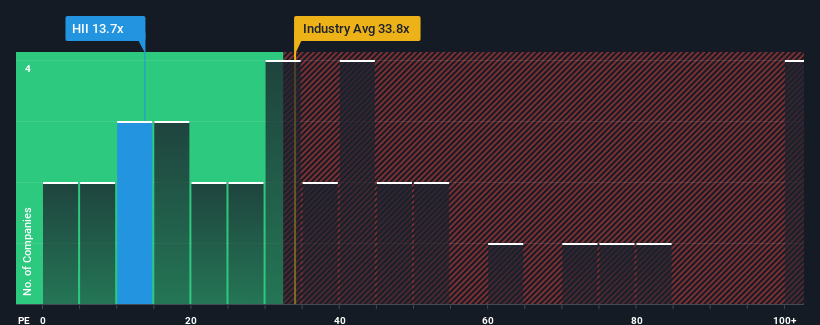- United States
- /
- Aerospace & Defense
- /
- NYSE:HII
Huntington Ingalls Industries, Inc.'s (NYSE:HII) Share Price Is Matching Sentiment Around Its Earnings

When close to half the companies in the United States have price-to-earnings ratios (or "P/E's") above 19x, you may consider Huntington Ingalls Industries, Inc. (NYSE:HII) as an attractive investment with its 13.7x P/E ratio. Nonetheless, we'd need to dig a little deeper to determine if there is a rational basis for the reduced P/E.
With its earnings growth in positive territory compared to the declining earnings of most other companies, Huntington Ingalls Industries has been doing quite well of late. It might be that many expect the strong earnings performance to degrade substantially, possibly more than the market, which has repressed the P/E. If not, then existing shareholders have reason to be quite optimistic about the future direction of the share price.
View our latest analysis for Huntington Ingalls Industries

How Is Huntington Ingalls Industries' Growth Trending?
There's an inherent assumption that a company should underperform the market for P/E ratios like Huntington Ingalls Industries' to be considered reasonable.
If we review the last year of earnings growth, the company posted a terrific increase of 45%. Still, EPS has barely risen at all from three years ago in total, which is not ideal. Accordingly, shareholders probably wouldn't have been overly satisfied with the unstable medium-term growth rates.
Looking ahead now, EPS is anticipated to climb by 5.7% each year during the coming three years according to the eleven analysts following the company. Meanwhile, the rest of the market is forecast to expand by 10% each year, which is noticeably more attractive.
With this information, we can see why Huntington Ingalls Industries is trading at a P/E lower than the market. Apparently many shareholders weren't comfortable holding on while the company is potentially eyeing a less prosperous future.
What We Can Learn From Huntington Ingalls Industries' P/E?
Using the price-to-earnings ratio alone to determine if you should sell your stock isn't sensible, however it can be a practical guide to the company's future prospects.
We've established that Huntington Ingalls Industries maintains its low P/E on the weakness of its forecast growth being lower than the wider market, as expected. Right now shareholders are accepting the low P/E as they concede future earnings probably won't provide any pleasant surprises. It's hard to see the share price rising strongly in the near future under these circumstances.
We don't want to rain on the parade too much, but we did also find 1 warning sign for Huntington Ingalls Industries that you need to be mindful of.
Of course, you might find a fantastic investment by looking at a few good candidates. So take a peek at this free list of companies with a strong growth track record, trading on a low P/E.
Valuation is complex, but we're here to simplify it.
Discover if Huntington Ingalls Industries might be undervalued or overvalued with our detailed analysis, featuring fair value estimates, potential risks, dividends, insider trades, and its financial condition.
Access Free AnalysisHave feedback on this article? Concerned about the content? Get in touch with us directly. Alternatively, email editorial-team (at) simplywallst.com.
This article by Simply Wall St is general in nature. We provide commentary based on historical data and analyst forecasts only using an unbiased methodology and our articles are not intended to be financial advice. It does not constitute a recommendation to buy or sell any stock, and does not take account of your objectives, or your financial situation. We aim to bring you long-term focused analysis driven by fundamental data. Note that our analysis may not factor in the latest price-sensitive company announcements or qualitative material. Simply Wall St has no position in any stocks mentioned.
About NYSE:HII
Huntington Ingalls Industries
Designs, builds, overhauls, and repairs military ships in the United States.
Undervalued average dividend payer.
Similar Companies
Market Insights
Community Narratives



